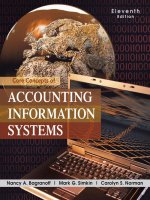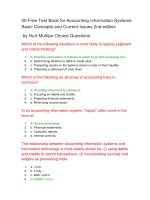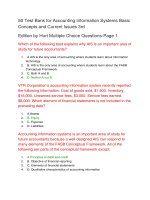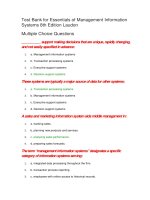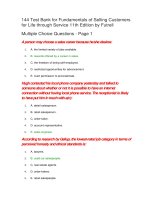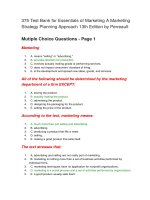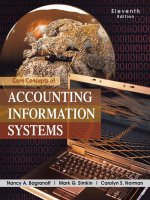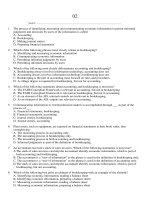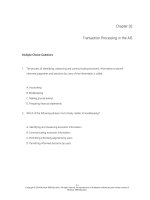Test bank and solution of accounting information systems basic concept and curent 4e by bob (1)
Bạn đang xem bản rút gọn của tài liệu. Xem và tải ngay bản đầy đủ của tài liệu tại đây (289.36 KB, 10 trang )
Accounting Information Systems: Basic Concepts and Current Issues (4th edition)
Dr. Bob Hurt, C.F.E.
End-of-chapter solutions
Chapter 2: Transaction Processing in the AIS
1. Reading review questions
a. In your own words, explain the similarities and differences between
accounting and bookkeeping. Bookkeeping is the subset of accounting activities
specifically concerned with recording transactions in the AIS, leading eventually to the
production of the four general purpose financial statements. Although both accounting
and bookkeeping require some elements of critical thinking, accounting probably
requires more. In addition, the essential elements of bookkeeping can be mastered in a
much shorter time than the entire body of knowledge in accounting.
b. What systems do accountants use to create and modify a chart of accounts?
In general, most charts of accounts follow a block or hierarchical coding system. In
block coding, similar items are coded similarly; for example, all current assets might
have account numbers that start with “1.” Hierarchical coding is good for more complex
charts of accounts, and is a specialized form of block coding. In hierarchical coding,
groups of digits have meaning. Such a system might be used in a business that has
multiple product lines and / or multiple geographic locations.
c. What internal controls are common in the accounting cycle? Internal controls
useful in completing the accounting cycle include: sequentially numbered documents,
adequate supervision, training & education and separation of duties. In addition, the
requirement that journal entries maintain the equality of debits and credits is also an
internal control.
d. How is human judgment involved in the accounting cycle? Human judgment is
required to recognize recordable transactions. To the extent that the accounting cycle
involves estimates (as with depreciation and bad debts), human judgment is also
important.
e. How has information technology been employed in the accounting cycle?
Information technology is an important component of most modern accounting
information systems; however, the technology is not the system. Common IT tools
employed in the accounting cycle include: general ledger software, spreadsheets,
relational databases and enterprise resource planning systems. Auditors can also use
IT to sample transactions.
f. List and discuss the six common types of adjusting entries found in most
accounting information systems. Accrued revenues occur when an organization
provides goods or services in one accounting period, but does not bill clients in that
same period. Accrued expenses, on the other hand, occur when an organization incurs
an expense, but does not pay cash until a subsequent period. Prepaid expenses are
assets purchased in one period that are used up over multiple accounting periods, while
deferred revenues involve the receipt of cash in one period for work that will be
performed in a subsequent period. Depreciation and bad debt adjustments both involve
estimates.
Copyright © 2016 McGraw-Hill Education. All rights reserved. No reproduction or distribution without the prior written consent of
McGraw-Hill Education
2-1
Accounting Information Systems: Basic Concepts and Current Issues (4th edition)
Dr. Bob Hurt, C.F.E.
End-of-chapter solutions
Chapter 2: Transaction Processing in the AIS
g. Explain the purpose and structure of each general-purpose financial
statement. AIS outputs associated with the accounting cycle include four generalpurpose financial statements. The income statement, which includes revenues and
expenses, reports the results of business activity on the accrual basis for a specified
period of time. The statement of shareholders’ equity tracks the changes in both paid-in
capital and retained earnings, also for a period of time. The balance sheet embodies
the accounting equation (assets = liabilities + equity), and reports financial position at a
specified point in time. The statement of cash flows comprises three sections
(operating, investing and financing), and reports the changes in cash for a specified
period of time.
h. In a manner specified by your instructor (e.g., individually or with a group, as a
written paper or as an oral presentation), prepare an original response to one or
more of the questions for this chapter’s “AIS in the Business World.” As in
previous editions, I’ve posted responses to each chapter’s AIS in the Business World on
my accounting information systems blog (www.bobhurtais.blogspot.com). Look for the
4th edition’s responses in the 15 December 2014 post.
2. Multiple choice review questions. Answers to all of these questions appear at the
end of the textbook itself.
3. Reading review problem
a. How should Regal code its chart of accounts to facilitate financial reporting?
Create account numbers for cash, capital stock and advertising expense for the
following Regal theatres: Regal O’Fallon Stadium 14 (O’Fallon, Missouri), Regal
Windward Stadium 10 (Kaneohe, Hawaii) and Regal Goldstream Stadium 16
(Fairbanks, Alaska). Regal should use some form of hierarchical coding for financial
reporting purposes. A three-part code could be appropriate, where one set of digits
denotes the state, a second set of digits denotes the specific theatre and a third set of
digits denotes the specific account number. The latter should be block coded.
Using that system would yield the results shown below for the accounts and theatres
noted. (The state code is based on an alphabetical listing of all 50 states. The theatre
code is an assumption; so long as it’s consistent within the same theatre, any two digits
should be OK. The account code is based on a standard block system.)
Regal O’Fallon Stadium 14
o Cash: 25.01.101
o Capital stock: 25.01.501
o Advertising expense: 25.01.701
Copyright © 2016 McGraw-Hill Education. All rights reserved. No reproduction or distribution without the prior written consent of
McGraw-Hill Education
2-2
Accounting Information Systems: Basic Concepts and Current Issues (4th edition)
Dr. Bob Hurt, C.F.E.
End-of-chapter solutions
Chapter 2: Transaction Processing in the AIS
Regal Windward Stadium 10
o Cash: 11.01.101
o Capital stock: 11.01.501
o Advertising expense: 11.01.701
Regal Goldstream Stadium 16
o Cash: 02.01.101
o Capital stock: 02.01.501
o Advertising expense: 02.01.501
b. Suggest three source documents Regal would use to complete the steps in the
accounting cycle. To pay its bills, Regal would use checks. It would use invoices as
the basis for writing those checks. Credit card / receipts for cash would be used for
things like ticket and concession sales.
c. What journal entries would Regal make to record the transactions indicated
above? Selling tickets: Debit Cash, Credit Sales. Paying employees: Debit Wages
Expense, Credit various liability accounts for withholdings, Credit Cash for net pay.
Purchasing snack foods: Debit Snack Foods Inventory, Credit Accounts Payable.
Advertising new films: Debit Advertising Expense, Credit Accounts Payable. Declaring
dividends on its capital stock: Debit Retained Earnings, Credit Dividends Payable.
d. What roles would human judgment and information technology play in Regal’s
transaction processing activities? Human judgment would be important in deciding
when and how much to pay in dividends, as well as in choosing which films to show in
which theatres. Information technology would allow Regal to send and receive data
electronically from its various theatres, as well as to produce financial statements
quickly and easily.
4. Making choices and exercising judgment
Students’ answers may vary significantly since the point of these exercises is for them
to think critically. Here are a few notes as a guide.
a. Recordable transactions are I and IV.
b. Principles-based accounting will probably not impact the design of the AIS at all,
since it focuses more on judgment in recording transactions and reporting
information. The steps in the accounting cycle are unlikely to change.
c. Students could calculate any of a variety of ratios, prepare common-size
statements or use other techniques.
5. Field exercises
Answers to these exercises will vary significantly. Although I’m not providing solutions
to them, don’t hesitate to share your students’ work with me if they come up with an
especially strong response.
Copyright © 2016 McGraw-Hill Education. All rights reserved. No reproduction or distribution without the prior written consent of
McGraw-Hill Education
2-3
Accounting Information Systems: Basic Concepts and Current Issues (4th edition)
Dr. Bob Hurt, C.F.E.
End-of-chapter solutions
Chapter 2: Transaction Processing in the AIS
6. Journal entries
a Cash
$
Capital stock
Additional paid-in capital
b Accounts receivable
Sales
c
1,750,000
$
50,000
1,700,000
10,000
10,000
Supplies
Accounts payable
3,000
3,000
d Utility expense
Cash
1,500
1,500
e no entry required
f
Wages expense
Cash
g Equipment
Cash
Notes payable
$
6,000
$
50,000
10,000
40,000
h Cash
Accounts receivable
5,000
i
Accounts payable
Cash
1,400
Interest expense
Interest payable
400
j
6,000
5,000
1,400
400
Copyright © 2016 McGraw-Hill Education. All rights reserved. No reproduction or distribution without the prior written consent of
McGraw-Hill Education
2-4
Accounting Information Systems: Basic Concepts and Current Issues (4th edition)
Dr. Bob Hurt, C.F.E.
End-of-chapter solutions
Chapter 2: Transaction Processing in the AIS
7. Adjusting entries.
a Depreciation expense
Accumulated depreciation
b Interest expense
Interest payable
c
Wages expense
Wages payable
$ 1,000
$
100
100
1,000
1,000
d Deferred fees
Sales
300
e Supplies expense
Supplies
650
f
1,000
300
650
no entry
g Bad debt expense
Allowance for bad debts
160
160
Copyright © 2016 McGraw-Hill Education. All rights reserved. No reproduction or distribution without the prior written consent of
McGraw-Hill Education
2-5
Accounting Information Systems: Basic Concepts and Current Issues (4th edition)
Dr. Bob Hurt, C.F.E.
End-of-chapter solutions
Chapter 2: Transaction Processing in the AIS
GLP Corporation
Adjusted trial balance
September 30, 20x4
Cash
$
Accounts receivable
Allowance for bad debts
Inventory
Supplies
Equipment
Accumulated depreciation
Accounts payable
Wages payable
Interest payable
Notes payable
Deferred fees
Capital stock
Additional paid-in capital
Retained earnings
Sales
Cost of goods sold
Advertising expense
Wages expense
Interest expense
Depreciation expense
Supplies expense
Bad debt expense
Miscellaneous expense
Totals $
6,000
2,500
$
360
4,500
150
15,000
11,000
1,200
1,000
100
6,000
600
7,000
8,000
11,000
16,300
13,500
5,000
13,000
100
1,000
650
160
1,000
62,560
$
62,560
Copyright © 2016 McGraw-Hill Education. All rights reserved. No reproduction or distribution without the prior written consent of
McGraw-Hill Education
2-6
Accounting Information Systems: Basic Concepts and Current Issues (4th edition)
Dr. Bob Hurt, C.F.E.
End-of-chapter solutions
Chapter 2: Transaction Processing in the AIS
8. Financial statements.
GLP Corporation
Income statement
For the quarter ended September 30, 20x4
Sales
Cost of goods sold
Gross profit
$
$
Expenses:
Advertising expense
$
5,000
Wages expense
13,000
Interest expense
100
Depreciation expense
1,000
Supplies expense
650
Bad debt expense
160
Miscellaneous expense
1,000
Net loss
16,300
13,500
2,800
20,910
$
(18,110)
Copyright © 2016 McGraw-Hill Education. All rights reserved. No reproduction or distribution without the prior written consent of
McGraw-Hill Education
2-7
Accounting Information Systems: Basic Concepts and Current Issues (4th edition)
Dr. Bob Hurt, C.F.E.
End-of-chapter solutions
Chapter 2: Transaction Processing in the AIS
GLP Corporation
Balance sheet
As of September 30, 20x4
Assets
Cash
Accounts receivable (net)
Inventory
Supplies
Equipment (net)
Total assets
Liabilities & equity
Accounts payable
Wages payable
Interest payable
Notes payable
Deferred fees
$
$
Capital stock
$
Additional paid-in capital
Retained earnings (deficit)
1,200
1,000
100
6,000
600
$
6,000
2,140
4,500
150
4,000
16,790
$
8,900
7,000
8,000
(7,110)
Total liabilities & equity
7,890
$
16,790
9. Coding systems
a. mnemonic
b. sequential
c. sequential
d. hierarchical
e. sequential
f. hierarchical
g. block
h. block
i. block
j. block
10. Terminology
1. F
2. D
3. C
Copyright © 2016 McGraw-Hill Education. All rights reserved. No reproduction or distribution without the prior written consent of
McGraw-Hill Education
2-8
Accounting Information Systems: Basic Concepts and Current Issues (4th edition)
Dr. Bob Hurt, C.F.E.
End-of-chapter solutions
Chapter 2: Transaction Processing in the AIS
4. B
5. I
6. G
7. A
8. H
9. E
10. J
11. Multiple choice questions
1. B
2. A
3. C
4. B
5. D
12. Statement evaluation
a. never true
b. sometimes true. The adjusting entry for an accrued liability is an example.
c. always true
d. sometimes true. The complexity of the chart of accounts will help determine
which system to use.
e. never true
f. sometimes true. The statement describes an accrued revenue adjustment; the
term “accrual” could also be used for an accrued expense.
g. never true
h. always true
i. sometimes true. Block coding facilitates closing entries, but not all automated
AIS use block coding.
j. always true
Copyright © 2016 McGraw-Hill Education. All rights reserved. No reproduction or distribution without the prior written consent of
McGraw-Hill Education
2-9
Accounting Information Systems: Basic Concepts and Current Issues (4th edition)
Dr. Bob Hurt, C.F.E.
End-of-chapter solutions
Chapter 2: Transaction Processing in the AIS
13. Excel application
Equipment basis
$
Salvage value
Estimated life
65,000
3,000
5
TPL Corporation
Equipment depreciation schedule
Straight-line
Year
1
2
3
4
5
Depreciation
expense
Accumulated
depreciation
$12,400
12,400
12,400
12,400
12,400
$12,400
24,800
37,200
49,600
62,000
Book value
$52,600
40,200
27,800
15,400
3,000
TPL Corporation
Equipment depreciation schedule
SYD
Year
1
2
3
4
5
Depreciation
expense
Accumulated
depreciation
$20,667
16,533
12,400
8,267
4,133
$20,667
37,200
49,600
57,867
62,000
Book value
$44,333
27,800
15,400
7,133
3,000
Copyright © 2016 McGraw-Hill Education. All rights reserved. No reproduction or distribution without the prior written consent of
McGraw-Hill Education
2-10
